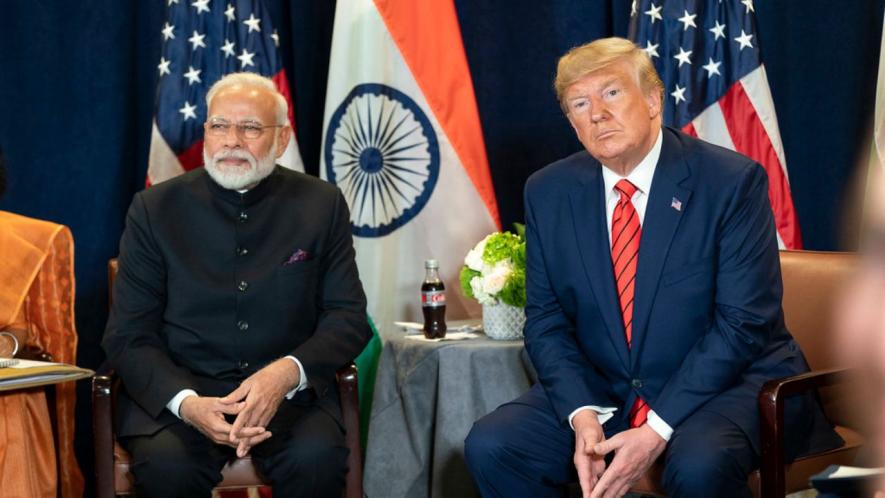Trump Tariffs: India Should Shun ‘Business as Usual’ Response

Image Courtesy: Flickr
Donald Trump has put off his proposed tariffs by 90 days; but countries like India have to respond to Trump’s measures whether now or after 90 days. These measures are not just an episodic act. Trump clearly threatens tariffs with any country that dares to act in a manner not approved by him. He is weaponising tariffs to assert US hegemony, quite apart from using them for economic ends like raising domestic activity and reducing the US current account deficit.
We are, in short, witnessing a new phase of world capitalism; and for countries such as India to pretend otherwise and carry on with “business as usual” would be absurd. “Business as usual” had brought great suffering to the working people of the country even in its heyday. To persist with it in the new situation will bring even greater suffering and even greater subservience to American dictates.
“Business as usual” had meant accepting the premise that the world market was growing rapidly, and countries like India would grow rapidly if they took advantage of this fact by “opening up” their economies and eschewing a dirigiste strategy, that is, a strategy of State intervention to enlarge their domestic markets for larger growth.
This was the formal argument behind neoliberalism; and this argument, absurd at the best of times (for reasons we need not discuss here), and particularly invalidated by the world economic slowdown following the collapse of the US “housing bubble”, has now been openly and effectively blown away by Trump’s bellicosity. Not to recognise this and persist with “neoliberalism” will bring disaster to the Indian people, to their lives and to their hard-won independence.
It may be thought that since the US and China are engaged in a tariff war, which virtually rules out their mutual trade, this is the time for countries like India to replace China in the American market, that instead of moving away from a neoliberal strategy, India should gain particularly from it now.
In fact, neoliberal spokespersons in India have been suggesting this. But even if we accept, for argument’s sake, that India’s exports to the US could rise in the short-run if it ingratiates itself with Trump, the fact remains that Trump’s objective is not just to replace China by other countries as America’s trading partners; it is also to reduce the US current account deficit, which means that any such short-term export gain at the expense of China cannot be sustained over time.
Read Also: Dealing With Trump’s Tariff ‘Madness’
What is more, even to obtain this short-term gain so that other countries do not grab it (in fact, countries would be competing against one another for grabbing China’s share of the US market by devaluing their currencies), there will be some depreciation in the exchange rate of the rupee. The rupee has already been depreciating and this will be further strengthened. Thus, if India does not take steps to raise its own tariffs against the US in retaliation against Trump’s tariffs, where the basic 10% tariff will continue in any case, then it will be witnessing a further exchange rate depreciation; and this is what even our own neoliberal spokespersons have been advocating.
Now, there is an aspect of exchange rate depreciation that is usually completely missed, namely, that it works by depressing real wages. An example will make the point clear: suppose a country was producing a good worth Rs 220, of which Rs 100 constituted imported inputs, Rs 100 wage cost and Rs 20 profit mark-up. Now if there is a 10% nominal exchange rate depreciation, then the value of imported inputs (which could include oil imports) will go up by 10% to Rs 110; if real wages and profit mark-up remain unchanged, then money wage cost will go up to Rs 110 and profit mark-up to Rs 22, i.e., by 10%, and the overall price will go up to Rs 242, which is 10% higher than before. But this means that since the rupee has depreciated by 10%, the dollar price of the goods would have remained unchanged, so that there would have been no real effective exchange rate depreciation even though there was a nominal depreciation of 10%.
For nominal depreciation to lead to a real effective exchange rate depreciation, therefore, either the real wage must fall, or the profit-margin must fall; but since the profit-margin is enforced by the capitalists in a capitalist economy, real effective exchange rate depreciation necessarily requires a fall in real wages. Tariffs, on the other hand, because they are selectively imposed, do not have this effect; they do not necessarily lead to a fall in real wages if they are not imposed on imported inputs or on imported wage goods.
Read Also: Trump’s Tariff War: ‘After Me, the Deluge’
The neoliberal spokespersons who want “business as usual” to continue despite Trump’s tariffs, by eschewing any tariff increase on the part of countries, such as India, but suggesting a currency depreciation instead, are basically suggesting an additional deliberate squeeze on the workers. They want neoliberalism to continue in the face of Trump’s tariffs, but they want the workers to pay the price for it.
And if Trump does not want other countries’ exports to replace Chinese exports, then the fall in real wages in countries, such as India, will not even be accompanied by any increase in activity and employment. (It could even lead to a lowering of employment if sellers of India’s imported inputs who become better off at the expense of Indian workers have a lower propensity to buy Indian goods than Indian workers).
Moreover, if the US does not want to replace imports from China by imports from other countries, while other countries depreciate their currencies at the expense of their own workers for getting a chunk of the US market that China has vacated, then this depreciation will go on and on.
And if speculators, anticipating depreciation, start taking money out of the country, then that will only further contribute to the fall of the currency, making life even more difficult for the workers. Neoliberal spokespersons who advocate a currency depreciation in response to Trump’s tariffs are either unaware of or unconcerned about the fate of workers following a depreciation.
Trump’s tariffs, in fact, provide an opportune moment to get out of the entire neoliberal regime, to impose retaliatory tariffs against the US, to maintain the exchange rate in order to prevent an import-cost-push inflation, and, in the event of balance of payments difficulties, to impose trade and capital controls.
All this has to be supplemented by an increase in the domestic level of activity and employment through an increase in government spending, above all on “welfare state” measures, financed by wealth taxation which ironically has disappeared in India. This would mean a reversion to a dirigiste regime of home market-based growth.
Any talk of such a reversion fills neoliberal spokespersons with dread; and such is the influence of their position, backed by the International Monetary Fund, the World Bank and other such organisations, and pushed through the monopoly-controlled media, that even common people look upon a return of dirigisme with some scepticism.
Three points, however, have to be made in this context: first, the pace of growth in a dirigiste regime depends essentially on the rate of growth of agriculture; and agricultural growth which has been choked in the neoliberal period because of the loss of profitability of agriculture will not only revive, but, if appropriate measures are adopted, even exceed what had been achieved during the earlier dirigisme. Dirigisme, in other words, would not mean just a return to what had prevailed earlier.
Second, even what had prevailed earlier had been better than what neoliberalism has entailed in the matter of basic foodgrain consumption. There has been a shooting up of absolute poverty, defined in terms of nutritional deprivation, in the neoliberal period compared with earlier. This is especially true of rural India where the proportion of total population unable to access even 2,200 calories per person per day reached a staggering 80% in 2017-18.
And third, the extent of income and wealth inequality even under the earlier dirigiste regime was much lower than what neoliberalism has been associated with. The figures provided by the World Inequality Database show that the share in national income of the top 1% of the population had been brought down to around 6% by 1982 (from around 12% at the time of independence); this share now exceeds 23%, which suggests a staggering growth of inequality. A necessary condition for the working people to take charge of their destiny is the transcending of neoliberalism for which Trump’s aggression gives an opportunity.
Prabhat Patnaik is Professor Emeritus, Centre for Economic Studies and Planning, Jawaharlal Nehru University, New Delhi. The views are personal.
Get the latest reports & analysis with people's perspective on Protests, movements & deep analytical videos, discussions of the current affairs in your Telegram app. Subscribe to NewsClick's Telegram channel & get Real-Time updates on stories, as they get published on our website.
























